Autonomous Learning in a Large Lecture Hall: POGIL and "Clickers"
Guang Jin, faculty of Department of Health Sciences, gjin@ilstu.edu
Tom Bierma, faculty of Department of Health Sciences, tbierma@ilstu.edu
Lucy Loftus, student of Department of Health Science, laloftu@ilstu.edu
Abstract
This project developed and evaluated two learning modules to promote autonomous learning in a large enrollment, general education course on environmental science. The modules utilized process oriented guided inquiry learning (POGIL) pedagogy, combined with a Student Response System ("clicker") to increase learner autonomy through a student-centered, discovery-based learning experience. One module focused on the development of pesticide resistance among insects and used a computer simulation to allow students to alter pesticide application factors and "discover" relationships with the outcomes. The second module focused on bioenergy and synthesized biodiesel from campus waste oil in class. Student volunteers participated in "mini-research" exercises in class.
Impact on learner autonomy, assessed through quizzes on reading material, indicated a small increase in performance following a POGIL module compared to other days, but the difference was not statistically signficant. Impact on student understanding, assessed by student performance on specific exam questions, indicated a small increase in performance compared to course sections that had not experienced POGIL, but again the difference was not statistically signficant. Student opinion about POGIL was very positive with at least 85% of students indicating that the POGIL approach was more interesting and increased their understanding.
The lack of statistically signficant benefits from the POGIL modules is not surprising, given that this was a pilot test, using POGIL in only two out of approximately 26 units in the course. However, the results, combined with in-class observations indicating dramatically higher student engagement, are strongly encouraging for greater application of POGIL in this course.
What is POGIL?
Process oriented guided inquiry learning (POGIL) is both a philosophy and a teaching/learning strategy that promotes more student involvement in class and seeks to engage students in learning (Farrell, et al., 1999; Hanson & Wolfskill, 2000, Hinde & Kovac, 2001; Hanson, 2005). In a POGIL classroom students work in self-managed learning teams on specially designed guided inquiry materials. These materials supply students with data or information followed by leading questions designed to guide them toward formulation of their own valid conclusions - essentially a recapitulation of the scientific method. The instructor serves as facilitator: observing and periodically addressing individual and classroom-wide needs (Amaral, et al., 2005; Hanson, 2005). POGIL has received significant funding from NSF to promote its adoption in undergraduate science, technology, and mathematics courses (NSF Award #0618800, #0618758, #0618746).
In a POGIL environment, students take on greater responsibility for their education (Bransford, et al., 2000; Donovan and Bransford, 2005; Hanson & Wolfskill, 2000; Hinde & Kovac, 2001; Hanson, 2005). Individual student responsibility for learning is fundamental to POGIL, but can be difficult to achieve in large lecture hall settings. Recently, recommendations have been developed for the use of POGIL in large classes (Amaral et al 2005). The primary recommendation for implementing POGIL and preserving learner autonomy is the use of "clickers".
Project Overview
The project developed and evaluated two learning modules to promote autonomous learning in a large enrollment general education course (HSC 156 - Environmental Health in the 21st Century). The modules utilized process oriented guided inquiry learning (POGIL) pedagogy, combined with a Student Response System ("clicker") to increase learner autonomy through a student-centered, discovery-based learning experience. Impact on learner autonomy was assessed by comparing student responses to pre-lecture reading assignments in POGIL units versus non-POGIL units. Student performance on subject matter covered using POGIL was also compared to previous semesters when POGIL was not applied. Student feedback on POGIL approach was also solicited through anonymous clicker response.
HSC 156 - Environmental Health in the 21st century - is a general education elective in "Outer Core - Science, Mathematics, and Technology" taken by over 800 undergraduate students each year. Class size averages approximately 100 in a lecture hall setting. A primary goal of the course is to use scientific methods of inquiry to understand environmental problems as they affect public health and personal well-being. To this end faculty have introduced Classroom Response Technology ("clickers"), allowing students to respond instantly to questions posed by the instructor. This new technology opens a unique opportunity to engage students in scientific "discovery" through a process guided by dialogue (mediated through the "clicker" system) and to hold students individually responsible for their learning.
Developing and Implementing POGIL Sessions
The two POGIL sessions developed and implemented were a "pesticide" session and a "biodiesel" session. The purpose of the "pesticide" session was to help students understand how pesticide application will produce short-term benefits in crop yield, but will ultimately produce a pest population resistant to the pesticide. The purpose of the "biodiesel" session was to help students better understand bioenergy, including the potential for bioenergy to reduce the threat of global warming, and the role of science in minimizing the conflict between food and biofuel. Both sessions were structured as an interactive exploration, one using a "hands on" simulation followed by a computer simulation, and the other using a variety of laboratory demonstrations. Both sessions were pre-tested on 10 environmental health majors in a "focus group" setting where the students provided on-going reflection and recommendations as we worked through the session. Lunch was provided for these students.
During the "pesticide" session, students, working in groups, used pieces of paper to simulate a population of insects with varying susceptibility to a pesticide. A level of pesticide was then "applied" and students, using simple criteria of pesticide susceptibility, determined which pests survived and reproduced. Next, we used a computer simulation that we developed to simulate a farm field's insect population and the effects of pesticide applications on the development of resistance. Using "clickers", students were able to "vote" for specific values of inputs to the model, such as the amount of pesticide applied, and then "predict" the outcome. By then observing the simulation outcome in terms of insect population and resistance, students were able to draw conclusions about how pesticides give rise to resistant populations, and about benefits and risks of pesticide use.
During the "biodiesel" session, students were initially asked to speculate on answers to a series of questions about energy sources. Answers to these questions lead to an understanding about our enormous dependence of fossil fuels, but also the vast potential energy that exists in "waste" biological material. Next, biodiesel synthesis from campus waste fryer oil was demonstrated in class, using a document camera to project the demonstration onto a large screen. "Clickers" were used to interactively lead students through an inquiry process about biomass energy and the problems with using vegetable oil as a transportation fuel. While the conversion reaction was occurring, 12 student volunteers participated in a test of viscosity, and the class compared the combustion properties of biodiesel and other fuels using Bunsen burners. Finally once the conversion was complete, the class assessed the conversion by looking for a phase separation and testing the viscosity of the product. All demonstrations were performed using the document camera to project the activity onto the screen so that all students were able to see it.
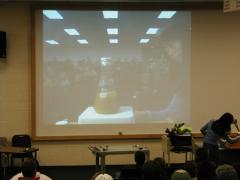
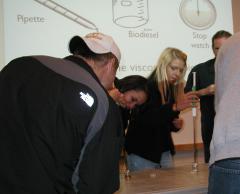
Results and Discussion
I. Impact of POGIL on learner autonomy
This was assessed by comparing student performances on pre-lecture quizzes following POGIL units versus non-POGIL units. For this course, students are assigned to read textbook chapters before lectures and they are quizzed on their readings using clickers at the beginning of a class. It is our hypothesis that when students are introduced to a topic through POGIL activities, they are more likely to be engaged in the topic and more likely to study on their own (learner autonomy), and perform better on pre-lecture quizzes. Results, summarized in Table 1, indicate a potential positive impact of POGIL on learner autonomy; however, the impact is not statistically significant. This is not unexpected since learner autonomy probably takes a long time to cultivate and we only implemented two sessions.
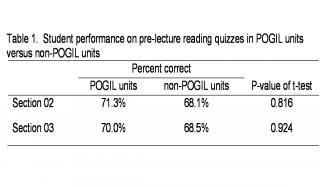
II. Impact of POGIL on Learning Outcomes
Student performance on specific exam questions dealing with subject matter covered using POGIL was also compared to previous semesters when POGIL was not applied and results are presented in Table 2. As indicated in Table 2, students appeared to perform slightly better on exam questions when POGIL was used as a pedagogy; however, the difference is not statistically significant.
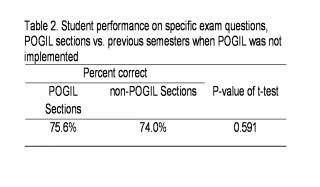
III. Student feedback on POGIL
Student feedback on each POGIL session was solicited through anonymous clicker responses during the following class period. Students were asked to respond to two questions: Q1: "The pesticide (or biodiesel) activity we performed in class last week helped make the material in this unit more interesting." and Q2: "The pesticide (or biodiesel) activity we performed in class last week helped me better understand some of the concepts in this unit." Students used their clicker to respond as "strongly agree", "agree", "neutral", "disagree" or "strongly disagree".
Student response to the pesticide POGIL session is summarized in Table 3a-c below.
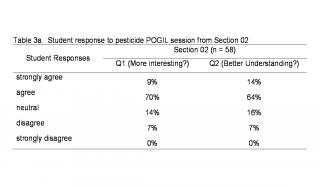
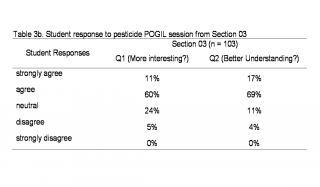
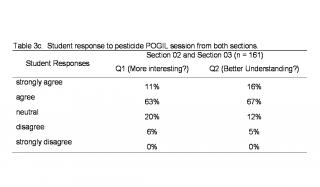
As indicated in Table 3a-c, student reaction to pesticide POGIL is positive. About three quarters of students either agreed or strongly agreed that the unit helped make the material more interesting, and helped them better understand some of the concepts in the pesticide unit.
Student response to biodiesel POGIL session is summarized in Table 4 below (only from section 02, data for the other section is lost due to technical problem with clicker software).
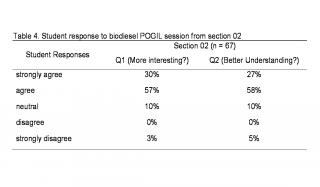
Student reaction to the POGIL/biodiesel unit was very positive. This was apparent from the level of engagement observed during the class as well as a very positive response to survey questions during the next class period. Eighty-seven percent of students either agreed or strongly agreed that the unit helped make the material more interesting, and 85% either agreed or strongly agreed that the unit helped them better understand some of the concepts in the energy unit.
Conclusions
Student perception of using POGIL pedagogy in large lecture hall was very positive. Student performance on pre-lecture reading assignments as well as exam questions all showed a slight improvement when POGIL pedagogy was applied. Although these impacts are not statistically significant, it signals some promise in using POGIL pedagogy in large lecture hall to promote learner autonomy and enhance learning outcomes.
References:
Amaral, K., Bauer, C., Hanson, D., Hunnicutt, S., Schneider, J., & Yezierski, E. (2005). A White Paper for Facilitating POGIL Activities in Large Classes. Presented at the POGIL National Meeting. Retrieved from http://www.pogil.org/resources/Large_class_final_version.htm
Bransford, J. D., Brown, A. L., & Cocking, R. R. (Eds.). (2000). How people learn: brain, mind, experience, and school. Washington, DC: National Academy Press.
Donovan, M. S., & Bransford, J. D. (Eds.). (2005). How students learn: Mathematics in the classroom. Washington, DC: National Academy Press.
Farrell, J. J., Moog, R. S., & Spencer, J. N. (1999). A guided inquiry general chemistry course. Journal of Chemical Education, 76(4), 570.
Hanson, D. (2005). Instructor’s guide to process-oriented guided learning. Retrieved from http://www.pogil.org/downloads/POGIL_IG.pdf
Hanson, D., & Wolfskill, T. (2000). Process workshops - A new model for instruction. Journal of Chemical Education, 77(1), 120.
Hinde, R. J., & Kovac, J. (2001). Student active learning methods in physical chemistry. Journal of Chemical Education, 78(1), 93.
This work is licensed under a Creative Commons License
This electronic portfolio was created using the KEEP Toolkit™, developed at the
Knowledge Media Lab of The Carnegie Foundation for the Advancement of Teaching.
Terms of Use - Privacy Policy